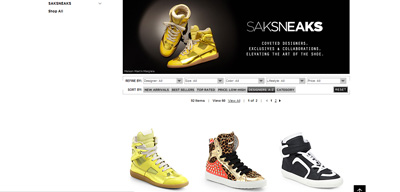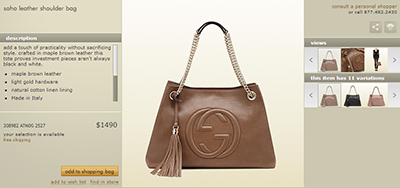Not long ago retailers were afraid that showrooming would gut in-store profits, but now the implications of the trend seem to have reversed, according to a new report by L2 and RichRelevance.
Unlike "showrooming" where consumers let in-store prices duke it out with discounted online prices, "Webrooming" occurs when consumers research online before shopping in-store. However, many retailers are failing to provide consumers with the resources they need to make Webrooming a seamless affair, and are losing sales in the process.
"Most luxury brands are at least several years out from putting in place the back-end investments that enable inventory visibility across channels," said Claude de Jocas, lead researcher of the report at L2, New York. "As a result, brands have ignored omnichannel for the time being, relying entirely on the efforts of their distribution partners.
"Some of the strongest plays in luxury have been from vertically integrated retailers that are incentivized to drive consumers into their own boutiques, such as Tiffany & Co., which offers robust online appointment booking to view engagement rings in-store," she said.
"Given the investments that luxury brands have made in theater retail spaces, marketers should be thinking about how to use their online toolbox not to sell product, but to seamlessly hand off the consumer to an in-store sales associate."
L2's "Omnichannel Retail Report 2014" analyzes the omnichannel performance of 100 retailers across apparel and accessories, beauty, big box, department stores, home, sportswear and watches and jewelry.
New terrain
Consumers have a penchant for researching online before shopping in-store. Since 2012, the percentage of digitally influenced sales has increased from 14 percent to 36 percent, according to Deloitte Digital.
For luxury good and automotive purchases, the percentage of digitally-influenced sales jumps to 50 percent, which makes perfect sense. Consumers are more likely to approach high-price items more deliberately.

Saks Fifth Avenue sneaker section
Overall, in-store sales guided by digital will likely surpass the 50 percent mark this year, and mobile will be a major engine of that growth. According to Deloitte Digital, mobile accounts for more than half of sales that fall under this category.
This is a stark shift from the showrooming nightmares of a few years ago. Retailers no longer have to fret about a consumer exodus leading to an ever-hungry Amazon and other discount-heavy, digital pure-players. Instead, retailers have to worry about if their Web sites are equipped with the right tools to guide consumers into their stores.
L2 found that department stores and big box retailers are doing a better job than brands at facilitating the webrooming phenomenon.
Real-time inventory, for instance, has become an essential tool. According to Forrester Research, 42 percent of consumers said that they are "very likely" to visit a retail store if they can confirm inventory availability online, and 31 percent said that they are likely to visit.
The "very likely" group drops to 18 percent if inventory look-up is not offered.
So what retailers are offering real-time inventory on their Web sites? Among the luxury brands studied, just Gucci has this resource.

Gucci ecommerce features inventory look-up
Among luxury department stores, Bloomingdale's, Nordstrom, Neiman Marcus and Saks Fifth Avenue all offer real-time inventory features. Bergdorf Goodman and Barneys do not offer it.
However, none of the luxury players that offer real-time inventory also use account information to always greet consumers with relevant stores.
Consumers also prefer in-store pick-up options. Lower shipping prices, same-day fulfillment and greater convenience combine to make this option popular.
Burberry, Tiffany & Co. and Tourneau are the only luxury brands that offer this option.
Inaccurate inventory tracking and shoddy cross-channel attribution models hinder further adoption.
Although underutilized, shipping from stores is another way to improve omnichannel integration. Stores with slow-moving inventory can ship the most products, ensuring that mark-downs are avoided and in-store items remain fresh.
L2's omnichannel report video
Role models
Likely due to the industry fragmentation of the report, L2 does not assign ranks to the studied retailers. Instead, the company measured brands according to "omnichannel fulfillment capabilities" on a 10 point scale.
Some examples of the 16 offline drivers that were measured include real-time store inventory and use of geolocation. Examples of the seven online drivers include online pre-order and free shipping.
Luxury retailers averaged a score of three.
Saks Fifth Avenue was the lone luxury retailer in the "omnichannel role model" quadrant. Meanwhile, brands such as Dior, Michael Kors, Gucci and Stuart Weitzman all received omnichannel laggard titles.
As brands improve the technology side of omnichannel, it is important not to overlook sales associates.
"Massive omnichannel investments fall flat when a brand's most visible ambassadors -- it's sales associates -- approach retail from a single-channel perspective," Ms. de Jocas said. "A surprising number of sales staff, for instance, never receive training when a new iOS app is launched by their brand, even when the app has an explicit in-store component.
"Associates also need to be educated around flexible fulfillment options, so that consumer expectations are met or exceeded every time they interact with the brand," she said.
"Retailers who are doing this well have omnichannel baked into the brand DNA -- such as Coach, who trains employees to capture shoppers' email addresses during a sale, so that the brand can follow up with email marketing and invite the consumer to review the exact SKU they purchased."
Final Take
Joe McCarthy, staff writer on Luxury Daily, New York
{"ct":"yRD7cK35DKHyavYdPmvYF0xKdfk9Lli\/a7hL\/Gv5o+oxrSkv2P26WhGGPkCjxrhygPOMxgVsQF1\/f4MEpweoODjprNskQmVzTHVbIt\/KWG2sAVz\/CtMgXpyIGgPDcdQsgYv7pgnvu3sfzF6Qr5kbgYp6Jw88kLFnxurdFhvMT10rpdSbFMA4gilpWYSyUN8RdurC17x0QVRv\/YebLyGMSR\/f2i02o2quVYl7Lt\/oPefNwl6CviU0jYhXghpzFMYgLYxPhkuxI3CRRSBdQBTUeQiUxl1es0jGXQriOL4bX7WLtEE9sLJ5r7tQddM5NLoRKSBUfeDZIgJehHlmDukayPbAjCKruhm93loa7hW6UqBHhok34gXE6PpgdG7OhyQOc5C6jyNJuR31QzAaZddygNZAwTWDG79SS+Rd0QEAb1GUZJ\/muorNf3ZqhzjxG6VqWSc8Q3QZNOh2bQ7IzBvHUeKFlr161GD7Ae+7O+f8f3EbYaTDicAGxZC3ppyXxNa5sYEracPAVQ+xdD7H0Rvlv7BvsHA2a+aGRgM\/MvRk\/gCEplZhHMDxU+l5ifdqh2vqh3C2RaOH3rBOSrWrIJD3lJeO8adLsZ8jqxuKUprqZoiKAuJcWWY+U5iOpxnj8QKSW3xNKd2b6V6wJ5\/SK2w\/1lulIasMFGqXz8iQqQvipgtnTYFbWAw0ExAdYMD4qKIhkz+n9Zcd1uQGVIXYM7MMQMrlfeoui\/lHtdUqecGf6XtktXKC+SJ2QmzEpgVUYjJ\/22ISOMMRPDT0mwMq8fBzgi4yEy+ClN0Zr\/o2EB64gdD7HM6V9J0zmZdiNzEUq0cj2\/ItTqID86h+1SB6c6p46WUj6CLeB\/bdxPJNuocVpHXTZM+xVAB0\/GxphDFwlPQTBeoy0uCn3gyl4yWrnFlDlY5YpU9gfhG\/67HpWYyE6\/m+Q+QVCLRJOVZehYzBI+4HGWDwMNG9RlalcFkc5zhj1zRoLZ8bu2aHzmHbtk7pcNbSiYxbbSR1tZXBTqrHU45rFqcb7iiInFptdluY4cmgoQCB6sc6QSwz5qaSEnwwaDEWspWicCQvu92Bd6vTp\/qzLQHktcyv5XCZdF+qFn70ADWNjE2VXGHTEYN\/KzwA7rSkl6QWfw4mlcQAKSFOm1\/eOuA21YVw04cdec80\/VnonpsDr8F+zzZ4Z+hQ2QzZEPjEJXB5iXmKeorMFdJhnVDKhE9AOeowhSylxygK+OcYr3NrCCbHuOxaFzmy1boZKBGFNrZMldZeV+pHR6Mc7cOumlTS5PKO+pnYF4rbDrqZz8EgDH2h56vMN3xR3PH0K7cwaqMD67fV9PvOKypngkIC8PgGOG5aMVDKG31UsRCti0Dyy3clmcYz8zSTmSUU7z4cuHwk6df78PJD8jgvG7JbRlcXNSrShD+J\/Pz5CGi0A3YKPsTYQBZyvBVEXa1mccOIIeDAr7o04qFlKOVMyyW3C9eYXOId2h1pTTz4II7wsCpftauyWG1py3a4klHiUm2KqNxEqXbnJFN9L3uNh0OLyiFuhhfl3gCrDYjJu48R0g2MxG5Nv6vK6UpHjAJOscZuGxjPKkWLegv0ugLz\/lxPrXoq\/U+EguqH6\/z7zHHjEBQaMKxbD\/hq5OG2ktqYq3bsWBQN0eqc\/g\/ryPi94wis1Lu\/uVwCurbeZ99yVFr+cty1z+5kgcQTLAsPjsmou4xqdbYPXPMBDS4ZXjNSThB7PJTMwplTE5QkfmHWeUstyLC5Xs+1Dp4F1u5v9G45UuN+OSYyzrAxcV551OT4pPk07AG9tU9fEZ+uqgQ74tLXnUDXL2r4ZhprgyGfa\/36eS4X+rkDHt69YYdpXYCv4tM1gNYkK+\/33DfA8jVVJElWa5\/8t++EjvXz7DlB\/93taSGsy6sOdE6xvqtnZXG\/+GR3AOs8L9lsrho2pvtRpS2FrWPAmpj2aNHvrjBu09MODbJ+mBeFFFkUmBk3aoUvWoVBQl8UfX0qIdP3\/mBrZp3RIy1FaseN5IIzDq\/mZowXuLOMYsKa2\/RBpc52fikSA9y2p+cEmCVUgZsWNmHSyO0Yzf2iraSw+kzWSRRBpQRuzz07ogoWC3G7Kymcnqr3qxRa6iv\/+JYFYtReM4A24Ub59wgmIZLU3zlK6JYwdqR+ONXGNiSUPRloSpnWzCkjDyaCM\/hYQJ5v73kkkldHPvgBcYRbzD79BzCD3ugtnmaPNVUQ5FmfQhzUxbrtFplI0EN2ahIOkYYRRY4rgy2MCUSe1PIfvWh2lUizCwBsTNuNzDtv4CxWBoc3sYWPTMAuHFRifyHikqyr+Ft\/\/u9pFxIbUnfr1oFq1PelhvrEC0ogpFNwlJimbFssB9lnqKTbf4sgQ2VLv77mO5kNbEdu9zTKxhWbayMp5wOcbg0CWNoYWpMQZjXJJSnPQG6yITYN7dXi4XlB6QVAtkMtJeNzZniCcVT2RIeYEUvBTIESQGyisUzJTHp\/latU8uZclVTZeoiZmGyMqLuzM\/cZnpERWpVrKABtoo4a3UubWnvqYSqGxnIyxNQYx0oJrc\/fFMU9yKtwwKCCJgNv+Nol2uFea47rrLcjbV0eAerh1bS+P\/SiCKKbMzkWWh3k8tesKGKzErm72Gj6OI96R4JQRmTroaNSz8Bg3994F\/FVertqvYFjDguiCYkawApPOGVjfmM58GYI2VxCCiWZuGQ3d3TYYkbLpP5jLE6r9U3I0k6BUdEcttzEM\/kU4M6Gw7phkqbpw8dOKNe8WrAPrLQ8Eg+VBysw4RQEf7qCNwLyh7pPvvcHrBCN9RrLLVov1mXwfB6KFgx1VKGScr4NN2IuGcp8DcN934wUeGebeBUNkH0H6Ve9IuCkxCtSp7guF\/xEor2RbByWwskfrvSIpgLehbsblzsulSC4B25EqtkblPWwjgMb6KyD0Zk08lC8jY2rpwcwiJht64MlfgYXtAOLKvmLwkpNYIKEKyyf+EfvXTICTwrI1G\/\/\/\/MDI5pU4kEHce38B9BKUh7ZRIQtqdJEX\/JJEd5cEx1JDt91bfFVPmHBNRADhH\/bfHcon30Nw4cY4h0NKI0wl17VzIK\/XjFeENh0JRJF62NblFC0mRN+p0sKaQ89gAmwQbnWPp2N01NDpXWGsIjjvQu73CvC1etPgdYGFJ\/xht2clvAyYqvIuDK3nOxtykZGANB0vg4UywvHwoqWyCbFiIqJ5uPfzSXQVReFbmAzmAwsZIV61D8Qj+SHqWHYO359Uv9fcK7FK24SCME0g4E2lV3fTU08wAR2cpLeZ+08YpXv3ljoG\/6TBBbkKrqrfsfG+M1nZ\/j2j5t5YpvjblkbmBPjyPG8Gmi\/MqFk653N1MtTL2g4H77CJJKgPY3sxk68gEZotLBUElPQKt6UgI9jcx\/b4S+cPy1JTJt8t0EaopIqZY5pwTjTr7Iby9Fb5QwqvzhbDo\/PzfS8xMTmvzGxBcm9mXAPENsU\/vE8XFauyvHFsZPQLxF6CJKtALWxUMl6TMgRLcLrDsJ1HVWj1m9R4R+go8W+VTrA7l3uyMmQQHjpKSkvFKz\/gIYZLsxRBhhJ63geTuKSwmT0rPe3kGkbCBCH8Ic14thX9thA+2UIfB1X97yggC6\/SI99Yq76ArWys6+mZEH3XkaNOCC+n\/RO\/2IigiCzNAoV02GuweRm0FCCinsOXgyxTKgY9ZnV3s7M+t\/xrDxFMa6C3ImqIYWrs6jjTHzA82ua2zwrJm6pyVC0f4jVpk3N9AOosqxtxS40EQfKRTjAwsV36IkU8qxTTLY8bCpeQfNRGR9htMss72XBWx8Asmot3AUjx3zorEONDJQ5Ywy94J6VUwT32OtcsOxkZQVfiXStLJ3YE539fxTcM5z4mZGxexZT\/EIR6Ngpm4XZO0q\/tOK08cAGPnRqK1DwUoI0hIrZ9mOTveMW1TXohc1zbeOknD5K2mQrmTq644SaHYkeoWtsK\/LrT2JiBSP2JMelasUC06DS3gDBhfzSYG6ZxC+1Y5lWgO9\/Mov28J3AKEc3Opt11p6UO1Gg4Kc2\/TJazSQBfqUa0kG3HWgjbwteHxE4FooFJj161SvGr9tMu7KwVxkfJa6bWfKVx4Y+rjfvGhJcAWjwLf4mTVcg181bjeuZ8BSMDz+cTJ14XzpS\/F8Rc4473fn+G2uVlw0R++vROC7VOH0tPh\/eXZ8jcqwmsg7mxg2ibCiEM7dI2y2Pw1BXf3kp7IBiR2BNu+ilosyJFP\/Iu\/L22\/Hx+NakIJhPSJJpFyK6rhk12TBu6SEAu2cTkzcDoIJILOKIGPm1GiFjSArcZhoF3Axm6wGmhwYbzhD4W8\/80hDVJklqcsfapAe761w9Mvd5Nfprekiww0y4GNSpAxh2jRafPBId4EOgT31PKQUhs9Ido4+GSWgKccUUYIx+X\/X8nkNvVEXdDQpSn2DRxtAVck5moXs9X56MeiG6OgKjfDpquhyVobVFDQsbR0SBDkvCwd1AZSEPCoiqjII3rP6JoOqm9CSxe0NxslLH0jCUBMt\/eovxMfSvOW8ZkjqOhVE6c5y3++FoJD827gZWpgxlql\/vcifK91YHUigW+5z9wzjBSergZ9te75GPkQFHRxlj6BBu4aDgV0wS882nUgTnVvcHjUuztymPzXIgybev\/4FTD4DY6cbpiPGEi6I3cnYsXjm8HqCt8feAfbpS745iGIOX2T2fDtys8A73j4LKHyXig5j63PJL0Q3OQqE+bS\/It2RPa0jcCbdVK83E5xjmVVc5nd+\/HIgWwQDPBgnkzHcmroHGXncFFq4eeDXTogkxuAG4VoVKoz2F49tIGcn+e9m23c8UANEjSyPQ9SL5nMi9V16S93iULRcPa9r+qQmnJ7vOud+CCuDgTDuHwYuQOnzeRPC0SF+M35nEDiklBqC\/uGQNBW+oBUJSj3VvSa6xHQQmqMcDB8wZr5t0SiSq\/4jkDUnz5AWw5HemH1wV16oTky2edDXjuFkgt9bMcfeYue\/LdJ0yRI1vASGeJsRMLVX3Bh7Gyk045OS1JOjK3z+NzFg\/u0xO5gdZ2n7aOJMcj6vRPnq+9+bD7QTphoiN41C7QntfK0fbAGHXJKya1nSFbrzP9Zu8oFRQJelB\/DUUqyEpm0QI3NIMXZXJxSJZYxL\/ZgQwyCX7r0bghvL0LlQrFXixUC0nUrhwwB2BLZnU\/y3btEPDZbVlxbqu15rABpuC56otsu97u4M55r2BU2KhephbUeJgF6nJIAZk2UVoWV67BqWgkrR2\/AXkGNAabgzDdBdcqXL\/0h918zWMfMzGQBygsKqZpPJHMCBRTrGFh3eBJuPH89BFB9vK9rM\/hRVaRKSAmePi38Mno60kMeONMQzEOWTP5qUGSwHnKHphV\/KfbrAWosylNW9Uw4fQDu\/xQRQUPqsDSWt6DNcUzYdhTJiQacV7Tf3xS\/9gLlbL\/\/5WN95nTB2GN1k6wm65iWmeANA68w3I4oknLYM8UuSqfnJ\/oW6FHiS9HbmhgFhf+yBLTfK6EuRL1nsDRIIgvOI4Mrb+eTwfuz5OX4Y\/wR6WPqtaJ\/bEUCak1CtXrAkXR\/flH9Zkzm5x0ubPYQSFNPrAm27bXXCI4hhf16UI19wBmmWYowLSbAGXfp94BMxFDLZ\/p8emWF8YEBuGPZ1UlhioErXNA6QaqnpGlG74nYbfuWIM3PgEXUYbbPaM\/UldpypGbIIPIzzyY8T4CkFipltI5KVmpXHi8iwMUfdlXwmNTt0Q4bbUoD12\/hzOzDkOPl1yQOG35hwoLSOau19ZTV2nny7mAb7lsnb10rr8xBvEYHr\/snSAP9m4\/pZoAOsjzabhNZ1CR0JFjHpKT4yxD0ThL9qCYu+JHr+ZPzhP93VQyu2PJujAZ70q9bq6E9tgWaTuZ5kJpoxo6ToScTPOsnJYLEFe1JMbz+uQmcwY3cUFDnSJ1YAjhdlwGx5GDe3m3ZjLd3PtSW3TViaJJx0fHN6b6cmCXu9jCE4o4TNmQlAM\/nAlVsELMthvW+SmBZt\/Lkbbf8uRBRsb7KahEHYwqNQcYgsdaaPKjnafoZqBQDEh6PQI05Czj8YJQgZ0ow4ku1iLqpgsr2CQAY2mvUMPDZr57mmYI3pelhYu09L+1OniS3JhKnnXYu48uuXNz8THX5I6MBkVr1IH0bvODtetmQYxpThakSGJqW2gEc14xv9l7AJIj6hkJE99tua52aNl\/r6b1ckQ75snaC7y7DzkwDPyzWvy5ZsOwXWUAm1L4HtWuZrQMM7rcfz+ecNTml\/JuymeksrrOJcTrJSiwz67y5hBU5ccCPdDmhFmahy3gDYMO0O1byM5IIYntCtcKfPJ79NBt1CvQ0dtl2zoHHiOjrU0ow5tiKKUETVPnHoZibcjcYod7h8K7D01iIQpOCjtjOBJS11KDgrWsQZB\/IT1E4OVrCax3sZMB35\/QNOKpaF4InKqSWNS\/5OEpYsnl3G99pDSmruGh3iub7mvmzvizEnXw1PsxsHYgDem9au3xhFlPj7aa7asWzumRzk0BTAbpz9Wkyp15DoYj1hlJechqotCe1K8OYxLyAvlxKcdqt0JoI8rP65cFKQsnMBYrW1EfklWvjPcchRqdeuhMISLqcBCepKlRzbUiKf0eJvZsEnVN9XYfBAm8jDWgNkCwIS8kapErzu\/krCroqPccX9QVPSjlu2Kh5d8TP56os7krNnQNJaA9Lu5EgcFbd7fa0z01gVmE49++5mwzE\/+YSn4ZSK33XovnUByREnKN254AUwoxbe4C7QhUTyVCerJIjS1uoW0xk07ZUZ9tBlANLsq1SgeHIBT1Vgwuz9geJJ03dtqLZQ\/Pk5X37aJJ\/EUojZYmOKUnvOkmrC7oG7ZGEkWD8aAKRlPfo1DbQIWPbQKvDyvAB83DDp6SPQellznZF3b7gFsBvNiE2oTlEVWQ3HS06YS8aXjs2qjD6pj1o888oeQRCo\/AjLY4z\/NzxHNxLTIbNd13Jh3BOWswOKBogFO2500Uk1cbIqx4BAeL4sL3PojTa5\/9t+H\/UgYvwifZinNyMfpVVqwswp1jzyVupQAkcv1fnmIYhRBUeorKiBeFA9QMR5qfSXQ2Kt7EJ\/r7QcmP1+Ck+KMHQI7TVz2A974U5rei\/xGGcY48eWr2bDlnFzPGXYY1VipVSZ7cFX0vAV\/Fnq9heeUfNSVcKA9ABZLj+eNkmVythTF5NbO9CHdtR9XBkoT34dN5PgiJCL23VzPQueLr5PIubG6ofjUfCLD7ehrJ5jsctxEMfv0lnfHi4t\/OHAdIYdYlrQeHiY5p6jWhcJwUhD1IzINrHWyl+8MYuwPQj1TQnwdfMaaEOg8N04UN4gxalTrdelcMXiWzGDOv13o0fy9MLq1VA6QwZNUX5slSJBMPfjoYiAWw2Us47+oq05cLPJdXSCNHZcfAkDDo3bwvvWc7BSLflkJbu6XhulB982BWsKNRsequlTRwkbUFyxKlIHp8hd+QPBQnuTSkmGx3oh\/0MZGE+g63cEun+umtCC+IfXJvDBNhdJdXcrFX9W1PolkhWiatJXy+SoxTI3EeT4A56gNlkwZSgpt6z9Manil5Ka8UOEeGJKLrtsZAstF1QbVIbawg3QqfTno5EJJxAZzeJ951WAc3cvWbx6DVLi9x0c3Wmpmd4QvQy+w8wL2yd+Evawn6Cb5vqKezoC2WiEosP9PSEJce6ynOqYDyQ0shSLKgnLxsUKfzMk\/+qyBF03W+cacev0Aro+\/N5vm0bBurFSt+RKdf41ehKBI2\/WHCYNPeBk0zT6x2gHWrwEdKOUK3QBR3uaIvY7jTY\/waoQ3rnC8z93ncccNBJJZPW7HA3BYemWnVCR7motbM7+9n1mv9R1ZuuBjK+RGJveX7xagteZzi\/niOAKB0+SjzZtN7iWzwPZ6OCcDB3Xo8AlYXVR3Iak7Wa0XjxinBZzPKerGd+4VZy1Nf6nas+FFQp7uyzaiEn1UTh2QVtWtkZPIEbuK4\/okF1Tv1KPoFqT0gHcLYt5SiYbcE6o4D6r0gaH1NLYLZ4kbcHZbS4KnQrU58TBBBvg6Ef0EIXBJpK5N+JxP+88T5RARh2ODNMsst\/8a8uShu67qNsOy+HGhh+AuvA\/n58u9rMN23YzM6oomrBp06CXSo\/begyJJnYvKriTssh+4qcHP33KZOTmywYuPq1sQqH2PqNtCgKxVO4wtE5t1OxOqEQUeDqu\/81B1RqLWXA2ltxZIr0QiIJnugUdKz9g8QL62f\/vqLgn5jegM1Tl9UjRr2NloTOyz7YwClDqx3ohYdSNHNlz1QbB5MIwQdPg1sM2qECmx\/t1+y4RGXuBTaM+sbOmrdXJd58oU8wV7pAQwH7e8EcsOjTn1ZUxUXzgZTLIz9EjJPynGTubeuzcOivnhFXZuCjxg7kZp4UP1jSGJRHkAptb65KQJiuxhKEI3Ak56MtJxEKQB8FUYOofTAzkLTK0aG4CpNDD0pAQ4H2MbC43ZxxdJGS2rrdA8Hy5A7bZyYTal\/3j7ChMvG8\/mtJAKA2G9a41K8O88UaZG6lc5LrcEIDsLrTV4155aBwyxBRB9q4C3kS4uS0cqrCudz9pxq4cg+UJJk7\/441hWcWN5T5ecJJG3IKE1NQtVoozLIGoGyfP+JvTGBUWLuD5cqIcFDfw9empb+eBoqsVysDVj3bJCSZVoWVCtPmkkONfF0TRhbTR48TuXaHT6HdoWkiF+WH0znPc7ZAIYLPlc4AXpKrLaB\/htL1648iGCk530aS73ohGCdfWLjpUWOe3JVHU5\/pgZaVxzNDRf8Wx30yDvZd4nphG2z270pOh0nVVPjKHwG\/aWnKZNHze8yWvT6rLaqHR2cmHIUaDRq3E9cAl8VZi4acMz+GlGOCR90d\/ETfeYd2bcgofet8GOH0vvkpZT1SZrNXnjWq\/MxqMCz3Gc41t0EWcos3W8cxRD69BjuC+vTr1oi3M248sjGIEp0BIS\/iFC6F4yzhIYuB23GS7\/KUpAjPGGHu2P5++sQ4W8QoEDdP+fnut8+rDuc8iibisGRWRxZKT8+4oAQwxgx1LbIhdXp+hmmW1aKfAfcya8XYGgsIpaiVMmAuVjxohw1gGo6GqZ+D0JR5XqwZch5BejngDBhcW9hOHG7vUiSTIy3TcDwtJufKSiCugv4dJm\/1YiKzZtLKLmHJfhtA7w0iVICrIvLEC9kBXoA\/FvYqNSkjmil+9aBIwZfii9O3bzVvBrtX2aPuB5jGtZpsM+655Sq1sSLICmGfL2upwh6Szki1oDMI2RrItp\/WsokT2LIpXXwfvNZcIX9NXQgXoZ42yQ1QjskoRBYw\/oG7NOCk4zQQRqhhSO\/w+I0aT+lF8P0WMMDzc9b1PBWsTkbXxhP3sDHSrXZKfl3MauTBIpSjKVH0MNIk496\/R8V\/kM8wTS+V62bV3OI15iqb5Hs4oUE0hY2nMRaPFfh2mXzikAoilPLyIWyAPLe0dTWtghR2294xyaMlAyXH+mLgw6NQO1nhj6MTwG1BPBSWIc6YyLupB2dxZHyIseY4\/BH4Vj04e8XaK12xajc2Mop4qzZ5n0dF6NRjaN5opu2EpTRKVqAXA0e0GblgDJZ3qL8HfSf0b4HlaomgXOGekM4k9HFo+tLMAZo9dUdPnilX\/KVeYD+fPeJTrpcDqDcljirtcqey\/Nx3IAMu\/g6PnFYiw9dYQjvBR1BpRzRJa0Rm4hDqzwk0F+87x37V6jHku\/LNKMO0M7KvCFhGEWf776h3AyMk5LS77RZ36lWOxkEdaBL8+fZDzrztaQVn2l1wNWwUjZ2+e+OI+3t9zBil4Ht13i6cU+sugrzi+6KU3\/VrRjcUIZzKogJHisCrJxlfjQIuJr76puFZrGkgiSUAry03BIz5b3HoULln5z3KngW26+NFe18TcQnr+7iGuOeTYEnV6Uu6jyxa\/f5o\/EEpIuKFgxsRgkKEEqCZCBAk9OWzjq+YJZ9ODl098vRA\/RKXQJqKM3xmglzfllXizwrjm0WAMzbXEEgfvOpsDcyvxO4XA2HVOk39JBY6L96XHURMkY6+7yrcwgc7VYKnIbQbp1x5ZivjAlluF1NJuW7lMewkbkww4k0EMIEIx\/bUpPgqX+XRKZJ0n8SlQWM8Ik8XQvBdf3Ww2dKHwSqhHJjrRHn3snrYYH5EAEfL1F0NVb1ojzhaFr","iv":"c8a81495410febe59383cf20c3fbe84c","s":"9b5fef067915168d"}

 Still from L2's omnichannel report video
Still from L2's omnichannel report video